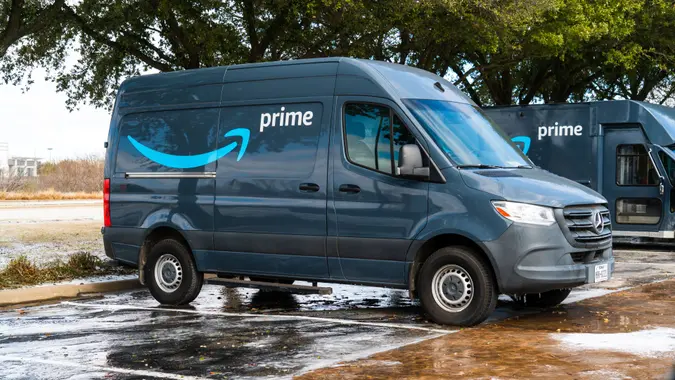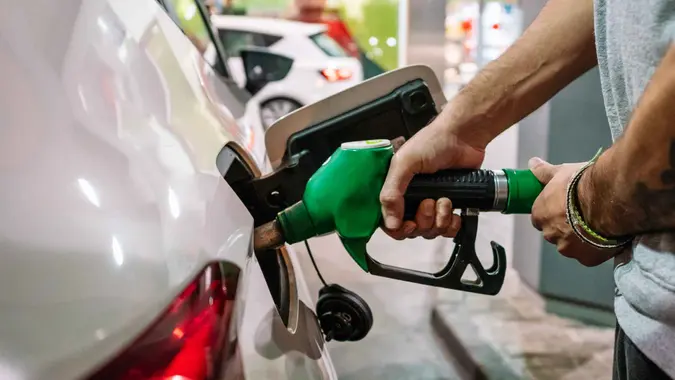Advertiser Disclosure
GOBankingRates works with many financial advertisers to showcase their products and services to our audiences. These brands compensate us to advertise their products in ads across our site. This compensation may impact how and where products appear on this site. We are not a comparison-tool and these offers do not represent all available deposit, investment, loan or credit products.
5 Ways To Save on Auto Expenses
 Written by
Andrew Lisa
Written by
Andrew Lisa
 Edited by
Carly Brashears
Edited by
Carly Brashears

Commitment to Our Readers
GOBankingRates' editorial team is committed to bringing you unbiased reviews and information. We use data-driven methodologies to evaluate financial products and services - our reviews and ratings are not influenced by advertisers. You can read more about our editorial guidelines and our products and services review methodology.

20 YearsHelping You Live Richer

Reviewed by Experts

Trusted by Millions of Readers
Although gas prices have gone down from their peaks last year — when the national average for a gallon was almost $5 — it’s still an expense hurting most people’s wallets. In order to offset gas inflation, car owners can look to other costs they may be able to cut down instead.
According to experts, here are five ways to save on auto expenses this year.
Know When To Switch the Windows for the Air
If you own a car, you hopefully know that you burn gas every time you turn on the AC to cool off. Obviously, it’s cheaper to roll down the windows, but it doesn’t take record-breaking heat for the blue side of the climate-control dial to beckon. In terms of fuel economy, though, is there a way to know when to make the move to mechanical cooling?
Hillary Swetz, of the frugal living website Homegrown Hillary, cited a study from The Society of Automotive Engineers, which identified a helpful formula.
“They found that if you’re going less than 40 mph, roll your windows down,” Swetz said. “If you’re going any faster, you’d create more drag on your vehicle and waste much more gas with the windows down, so use the AC at higher speeds.”
Restarting Is Cheaper Than Idling
Not only is idling your engine bad for the environment and rude to the people around you, but it burns up to a half-gallon of fuel per hour, according to the Department of Energy (DOE).
“There is no reason to allow your car to idle if you are sitting in it and not driving,” said Phil Dengler, co-owner of The Vacationer. “It burns gas and is bad for your engine and other internal components. Turn your car off and restart it when you are ready to drive.”
Although you should try to limit it to 10 times per day, restarting your car burns only 10 seconds worth of gas, according to the DOE.
Make Sure Your Tires Are Neither Squishy Nor Hard
Not only are properly inflated tires safer, but they save you money in two ways: They last longer than improperly inflated tires and they get better gas mileage. In fact, properly inflated tires can boost your mpg by up to 3%, according to the DOE.
“Some folks only inflate their tires when they prepare for a road trip or get an oil change,” said Robert Walden of Vehicle Freak. “Checking your tire pressure weekly can help you save on gas. When you drive with deflated tires, your car has to work harder to move, so it uses more gas. Keeping those tires inflated ensures that your engine works only as hard as needed.”
How Is Your Gas Cap Looking?
For most people, the gas cap is an out-of-sight, out-of-mind part — especially if you live in a state that doesn’t let you pump your own gas. If it’s worn and weathered, however, a few bucks invested in a new one could improve fuel economy and keep your car running better.
“Your gas cap should be airtight,” Walden said. “If it’s not, the gas in your tank will evaporate and leak out when your car is dormant. Check your cap to make sure the seal looks healthy. Replace it if there are any holes, tears or other signs of damage.”
Be a 1 Percenter
In 1980, 35% of the cars produced for sale in the U.S. had manual transmissions, according to The New York Times. But, by the summer of 2021, that number had fallen to 1%. The dwindling dinosaurs who can still drive cars with three pedals might be able to lower their gas bills — but only if they’re shopping used.
“Vehicles with manual transmissions are more fuel-efficient than automatic vehicles,” Walden said. “Automatic transmissions use fuel to shift gears, so automatic vehicles burn gasoline at a faster pace.”
That was almost always true until recently, according to Edmunds, but modern automatics have improved enough in recent years to surpass comparable sticks. So how far back do you have to go to find a car with a clutch that pays you back in the form of better gas mileage? It depends on the model; but, as recently as 2015, Consumer Reports was still advising that “most manual transmissions can deliver better fuel economy and acceleration.”
More From GOBankingRates
Share This Article:




You May Also Like


'Revenge Saving' Is the New Financial Flex -- Here's Why You Should Join In
October 06, 2025
5 min Read


5 Halloween Items To Score During Amazon Prime Big Deal Days If You're on a Budget
October 06, 2025
5 min Read


4 Features That Make Your Car Lose Value Instantly, According to Car Experts
October 06, 2025
5 min Read

6 Reasons Your Staycation Might Be Way Cheaper at a Hotel Than Anywhere Else
October 06, 2025
5 min Read

I Asked a Contractor and Other Experts What I Should Never Buy at Home Depot: Here's What They Said
September 29, 2025
5 min Read





Here's What Happens When You Stop Shopping for 30 Days, According to Tori Dunlap
October 06, 2025
5 min Read

I'm a Frugal Shopper: Always Buy the Cheapest Version of These 7 Foods
September 19, 2025
5 min Read

Best Ways To Save Your Money
Make your money work for you
Get the latest news on investing, money, and more with our free newsletter.
By subscribing, you agree to our Terms of Use and Privacy Policy. Unsubscribe at any time.


Thanks!
You're now subscribed to our newsletter.
Check your inbox for more details.



Sending you timely financial stories that you can bank on.
Sign up for our daily newsletter for the latest financial news and trending topics.
For our full Privacy Policy, click here.
Looks like you're using an adblocker
Please disable your adblocker to enjoy the optimal web experience and access the quality content you appreciate from GOBankingRates.
- AdBlock / uBlock / Brave
- Click the ad blocker extension icon to the right of the address bar
- Disable on this site
- Refresh the page
- Firefox / Edge / DuckDuckGo
- Click on the icon to the left of the address bar
- Disable Tracking Protection
- Refresh the page
- Ghostery
- Click the blue ghost icon to the right of the address bar
- Disable Ad-Blocking, Anti-Tracking, and Never-Consent
- Refresh the page



